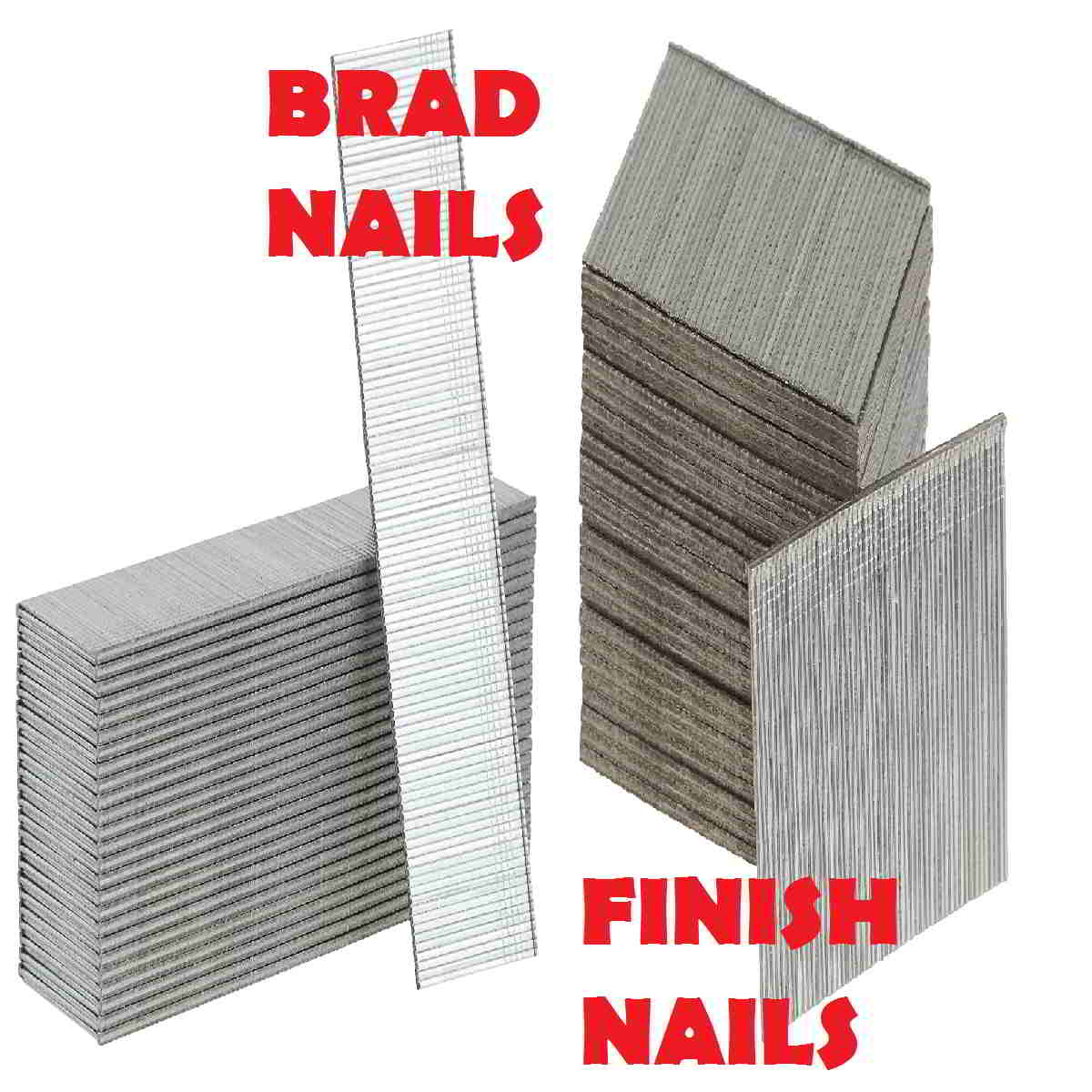As an Amazon affiliate, we may earn a small commision from qualifying purchases.
In this article, we shall be running a comprehensive brad nail vs finishing nail comparison- we are doing this to help you make the right decision when it comes to choosing the right nails for your projects particularly if you’re a newbie to woodworking.
Without wasting your time, let’s dive into our brad nail vs finishing nail matchup..
Brad nail vs Finishing nail: Which would be better?
I should mention this before we get into more specific details:
Each type of nail has its purpose so the key question, as far as the best nail type goes, is “what projects do you have in mind?”.
Let’s now turn to the specifics to help you better understand what I mean:
What are brad nails?
Brad nails are usually 18 gauge nails, typically up to 2” long.
So, what do they use to make the 18 gauge brad?
Well, you guessed it right: They make them using 18-gauge steel wire.
Now, the smaller 18-gauge diameter makes brad easier to mask in paneling or wood trim.
What are finish nails?
Finish nails are, in contrast, larger 15 or 16-gauge nails, which are a bit longer (they go up to 3 and 1/2 inches).
Put another way, finishing nails are made of either 15-gauge or 16 gauge steel wire and hence they’re slightly thicker than brad nails.
I don’t want to get you lost with respect to the aforementioned gauge numbers: The smaller the gauge number, the bigger the diameter of the nail. The opposite of this is also true!
To put everything in black and white, 18 gauge=0.0475-inch, 16-gauge = 0.0625-inch, 15-gauge=0.0703125-inch.
Just so you know, there are a couple of 14-gauge finish nails but you won’t find them as easily as the 15-gauge and 16 gauge models.
Where to use brad nails
As mentioned, brad nails are typically 18 gauge and you can them for a range of jobs –but principally they’re best for small, delicate trim work.
I should add that they especially shine in projects such as making jigs as well as face frames and also where clamping can be too time consuming/awkward.
One major concern is that they don’t have a lot of holding power though, on the other hand, you don’t need to fill/cover the holes as they’re much smaller.
Just keep in mind that for some projects, people use glue + brads- the Brads will provide good enough holding power whilst the glue dries (and will, again leave a very tiny hole so the final product will be much cleaner looking).
Where to use finish nails
Finish nailers are, in general, intended for finish work…
Here is what we advise: For trim work, finish nails are great if you’re installing typical casing (and baseboards) to walls.
You’re also unlikely to have trouble with quarter-round either.
The truth, however, is, that you can use finish nails for a multitude of projects (Think of trim, base board, crown moldings, chair rails, and more)
This raises a new question: So, where exactly can you use finish nails and where specifically should you use brad nails?
Here is the general rule of the thumb:
You should use brad nails for very small / thin trim which finish nails would split (brad nails would be useful for such).
As regards woodworking construction, you can, of course, use brad nails to secure joints (again while the applied glue dries).
You can also use brad nails to attach trim to pieces.
Back to finish nails and their extra holding strength makes them the go-to nails for building items like cabinet boxes.
You may also want to use 16 gauge finish nails for hardwood floors, MDF boards, plywood, and definitely for tasks like hanging interior doors, shelf cleat, and the like.
In a nutshell, use brad nails for softer materials and finishing nails for all denser materials.
Oh, and you can always use filler to mask finish nail’s heads (they are not that big either).
Brad Nailer Vs Finish Nailer: A word on the best nailers for the job
If you’re debating which brad nailer to buy, we recommend Ridgid brad nailer..We love the easy switching between bump and sequential fire, it’s lightweight, comes at a reasonable price, etc.
This porter cable can be another fantastic choice (it’s more expensive)- it very rarely jams up, it is very consistent, and feel good to use too.
In the same vein, Dewalt and Makita also have popular brad nailers of similar quality.
In terms of a nailer for finish nails, get an angled finish nailer such as this Metabo 16-gauge HPT Finish Nailer as they’re way better for corners.
Finally, we tend to recommend pneumatic nailers over cordless nailers.
Why?
You see, while you’ll have the initial compressor expense, pneumatic nailers are themselves way cheaper.
Not only are Cordless nailers quite a lot more costly to use (in the long-run) but they are also notably louder. Above all, they’re move convenient if you’re into more roaming work.
Brad nail vs Finishing nail -In summary
Brad nails are typically thinner and shorter while Finish nails are usually longer and a little fatter.
Brad nails are, in general, best for small, delicate trim work- Think about decorative moldings, plain panels, or even under stair treads.
Meanwhile, finish nails are more ideal for finish projects where more holding power is necessary (remember they are fatter and longer than brads!)
With respect to the best nailers for each nail type, get an angled finish nailer like the Metabo 16-gauge HPT Finish Nailer as they’re way better for corners. The Ridgid brad nailer is our top pick for brad nails!
You can as well pick a finish nailer-they’re more versatile, by far, than brad nailers (and takes several nail lengths including brads depending on the brand).
ALSO READ:
18 gauge brad nail vs 16 gauge finish nailer :Which is the best for your projects?

